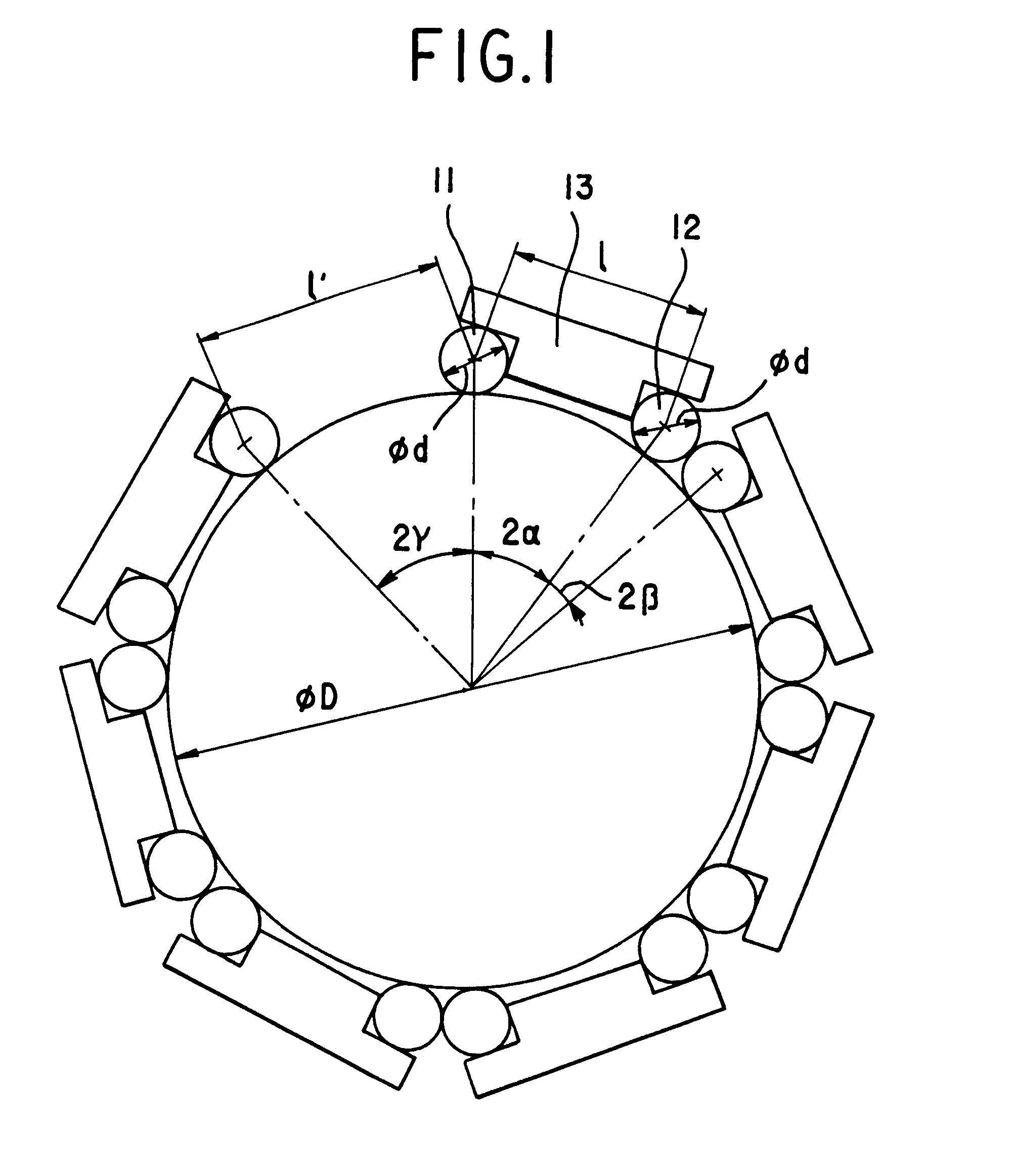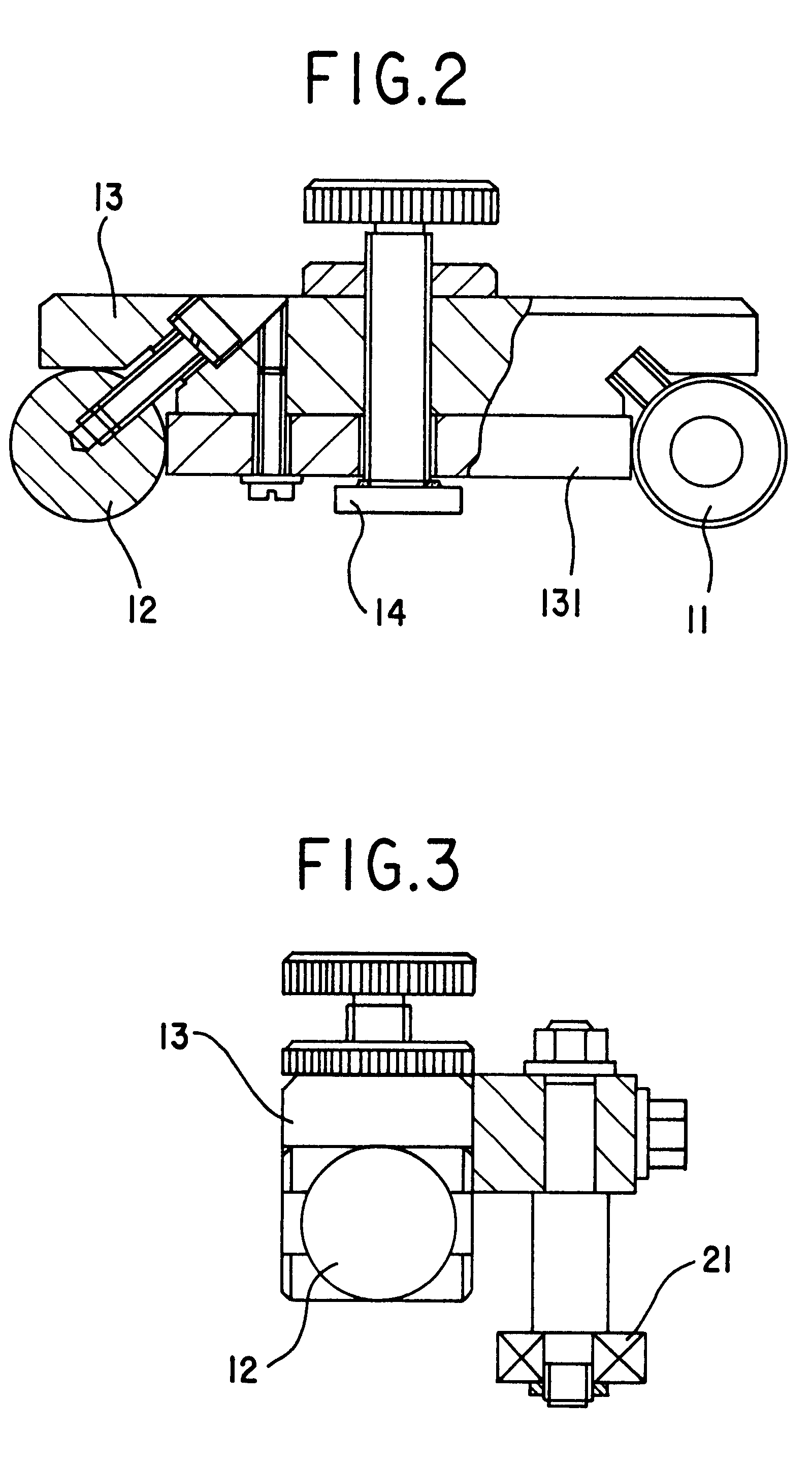Gauge for measuring large diameter
a gauge and large diameter technology, applied in the direction of mechanical diameter measurement, measurement devices, instruments, etc., can solve the problems of large deformation, high cost, poor repeatability, etc., and achieve the effect of small volume, high accuracy and simple structur
- Summary
- Abstract
- Description
- Claims
- Application Information
AI Technical Summary
Benefits of technology
Problems solved by technology
Method used
Image
Examples
first embodiment
As shown in FIG. 1, positioning elements 11 is a roller, but 12 can be a ball or a roller. When the two positioning elements are rollers, their axes should be parallel each other. The two positioning elements are fixed at the two ends of the body 13. A measuring block 131 is also installed on the body 13, its two ends contact with the two positioning elements (FIG. 2). The accuracy and accordance of each gauge's central distance can be guaranteed by current manufacturing technology of standard blocks. There is an adjustable screw at the center of the body 13. A fastener 14 of permanent magnet is arranged at the end of the screw. The above-mentioned elements form a measuring gauge of this invention. The measuring gauges are attached and fixed firmly on the out- or in-circumference of the steel- or iron-made workpiece by fastener 14. The magnet force between the gauge and workpiece can be adjusted by turning the screw. In order to improve the contacting condition between the end surfa...
second embodiment
When the diameter of the workpiece is very large, the size of the gauge is large also. The fastener 14 is a magnetic-force-conversion device with a main permanent magnet 142 and a handle (FIGS. 6,7). The fastener is located on the middle of the gauge. While turning the handle, the magnetic path can be switched-off and switched-on. Thus, the magnet force can be created or eliminated. The principle of it is the same as that of the magnetic gauge stands applied in the filed of precision measurement. If necessary, the auxiliary magnets 141 can be set at the both side of the magnetic-force-conversion device. They are fixed on the screws. Their magnetic force is smaller than that of the main magnet. By turning the screws, the distance and then the magnetic force between the two auxiliary magnet s and the workpiece can be adjusted. The aim of employing the auxiliary magnets is to simplify the operation. That is, firstly have the main magnet do not work, then place the gauge to the workpiec...
third embodiment
As shown in FIG. 8 and FIG. 9, the body of the gauge is mainly composed of the pole or pipe 131, left brace block 132 and right brace block 133. The reason of employing the pole or pipe 131 as the main part of the body is to increase the length of the gauge and then the measuring efficiency. Because the gauge is long, two permanent magnets 141 and 142 are arranged at both sides of the gauge to ensure the enough magnetic force. Wherein 141 is located within the right brace block 133 (not shown) as the same way like 142 within the left one. The positioning element 12 is a roller in FIG. 8 and FIG. 9. It can be a ball also.
PUM
 Login to View More
Login to View More Abstract
Description
Claims
Application Information
 Login to View More
Login to View More - R&D
- Intellectual Property
- Life Sciences
- Materials
- Tech Scout
- Unparalleled Data Quality
- Higher Quality Content
- 60% Fewer Hallucinations
Browse by: Latest US Patents, China's latest patents, Technical Efficacy Thesaurus, Application Domain, Technology Topic, Popular Technical Reports.
© 2025 PatSnap. All rights reserved.Legal|Privacy policy|Modern Slavery Act Transparency Statement|Sitemap|About US| Contact US: help@patsnap.com



